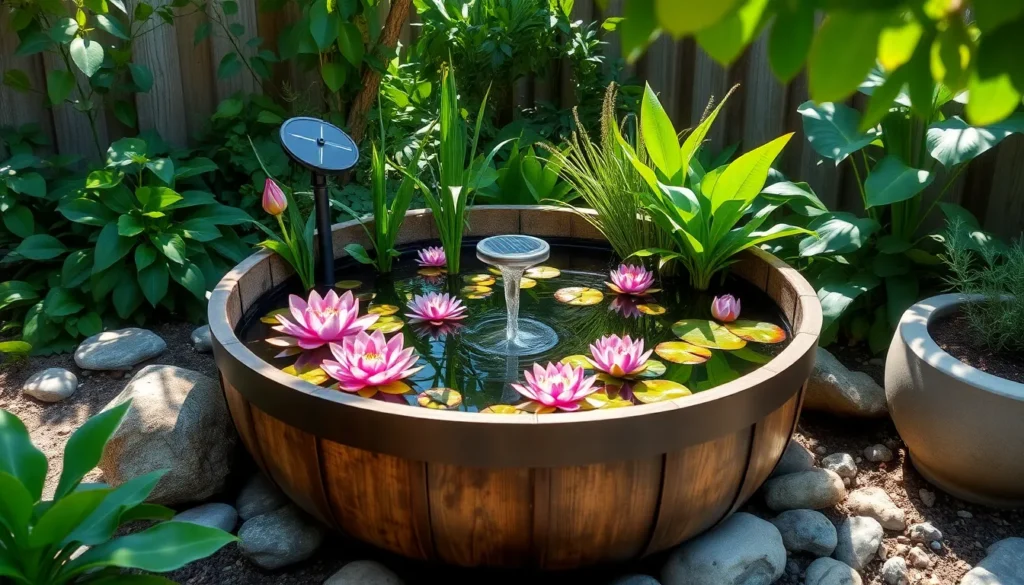We’ve all dreamed of having a tranquil water feature in our backyard but assumed it required massive excavation and hefty budgets. Container ponds shatter that myth entirely. These compact aquatic gardens transform any space into a serene oasis using nothing more than a simple container and creative vision.
Container ponds offer endless possibilities for both seasoned gardeners and complete beginners. Whether you’re working with a tiny balcony or sprawling garden space we’ll show you how to create stunning water features that rival traditional in-ground installations. From repurposed whiskey barrels to sleek modern planters the options are limitless.
The beauty of container ponds lies in their flexibility and instant gratification. You can relocate them seasonally protect them from harsh weather and even bring smaller versions indoors. We’re about to explore dozens of innovative container pond ideas that’ll transform your outdoor space without very costly or your back.
Choose the Perfect Container for Your Pond Project
Selecting the right container forms the foundation of your container pond success. We’ll explore the most popular and practical options that deliver both functionality and aesthetic appeal.
Repurpose Large Ceramic Pots and Planters
Ceramic containers offer exceptional durability and natural beauty for pond projects. Large glazed ceramic pots provide excellent water retention without requiring additional liner materials. Terra cotta planters create rustic charm but need sealing to prevent water seepage through porous surfaces.
Choose containers measuring at least 18 inches wide and 12 inches deep to support aquatic plants and maintain stable water temperature. Wide ceramic bowls work perfectly for shallow water gardens featuring floating plants like water lilies. Decorative urns add elegance to formal garden settings while providing ample space for pond ecosystems.
Consider drainage before installation since most ceramic planters include drainage holes that require sealing with aquarium-safe silicone. Heavy ceramic containers stay put during windy weather but need sturdy surfaces to support their weight when filled with water.
Transform Wooden Barrels and Whiskey Barrels
Wooden barrels create charming rustic pond features with authentic character. Half whiskey barrels offer ideal proportions for container ponds measuring approximately 26 inches across and 18 inches deep. Wine barrels provide similar dimensions while adding vineyard aesthetics to your outdoor space.
Prepare wooden containers properly to ensure water safety for aquatic life. New barrels require thorough rinsing to remove residual alcohol or chemicals that could harm fish and plants. Apply food-grade sealant to prevent water absorption and extend the barrel’s lifespan.
Position wooden barrel ponds strategically since they’re difficult to relocate once filled with water and established plants. Cedar barrels resist rot naturally while oak barrels offer traditional appeal with proper maintenance. Consider adding metal hoops or bands for additional structural support.
Use Plastic Storage Containers and Kiddie Pools
Plastic containers provide affordable and versatile pond answers for every budget. Large storage tubs offer excellent value while kiddie pools create spacious water gardens at minimal cost. Food-grade plastic ensures safety for fish while lightweight construction allows easy seasonal relocation.
Select containers with smooth interior surfaces to prevent damage to pond liner and aquatic plants. Rigid plastic storage bins maintain their shape better than flexible kiddie pools that may buckle under water weight. Black or dark-colored containers help disguise plastic appearance while reducing algae growth.
Enhance plastic container aesthetics by surrounding them with decorative stones or embedding them partially in the ground. Rectangular storage containers fit well in corner spaces while round kiddie pools create natural-looking pond shapes. Consider multiple connected plastic containers for tiered water features.
Create a Miniature Water Garden Paradise
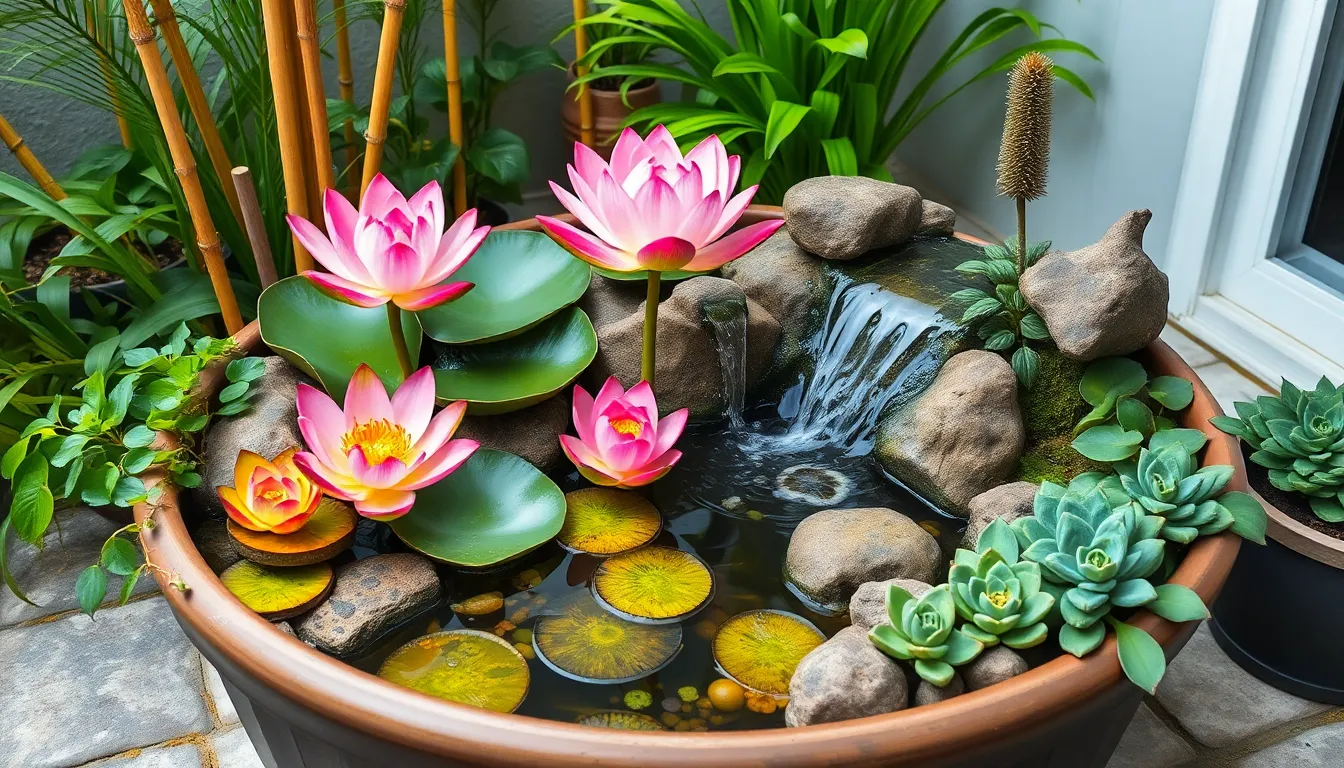
Transform your container into a stunning aquatic network that brings nature’s beauty to any space. Waterproof containers measuring at least 18 inches in diameter and 5 to 8 inches deep provide the perfect foundation for these enchanting displays.
Design a Lotus and Water Lily Display
Larger containers accommodate the expansive growth patterns of lotus and water lily plants beautifully. We recommend placing these aquatic stars in separate large pots within your main container to control their spread and simplify maintenance. Position each plant strategically to allow adequate room for their impressive foliage to unfold naturally.
Container specifications ensure optimal growth conditions for these water garden centerpieces:
| Plant Type | Container Size | Depth Required | Spacing |
|---|---|---|---|
| Lotus | 35+ gallons | 12-18 inches | 3-4 feet apart |
| Water Lily | 20+ gallons | 8-12 inches | 2-3 feet apart |
Submerged branches create essential escape routes for visiting wildlife while adding natural architectural interest to your display. These decorative elements serve dual purposes as both aesthetic features and functional wildlife habitats.
Build a Succulent and Aquatic Plant Combination
Drainage becomes crucial when combining these contrasting plant families in one container system. We suggest selecting containers with adjustable water levels to accommodate both succulent varieties like Sedum and aquatic plants such as Pistia stratiotes effectively.
Water level management requires careful attention to each plant’s exact needs. Succulents thrive in well-drained sections while aquatic plants need constant submersion for healthy growth. Creating terraced levels within your container allows both plant types to flourish simultaneously.
Sedum varieties add textural contrast against the smooth surfaces of floating aquatic plants. This combination creates visual depth while showcasing the diversity possible within container pond designs.
Establish a Zen-Inspired Bamboo Water Feature
Bamboo elements introduce natural filtration capabilities while creating stunning vertical interest in your water garden. We incorporate bamboo as both decorative accent pieces and functional components that enhance water quality naturally.
Sound elements transform your container pond into a meditative retreat through gentle water movement. Small fountains or waterfall features create soothing sounds that mask urban noise and promote relaxation.
Water mint and Mentha aquatica cascade gracefully over container edges for that authentic zen garden appearance. These aromatic plants release pleasant fragrances when touched by gentle breezes, captivating multiple senses in your outdoor sanctuary.
Native plant selections like Hymenocallis caribaea and Houttuynia cordata provide vibrant colors throughout growing seasons. Floating plants including water lettuce and water hyacinth add surface texture while helping maintain balanced water conditions naturally.
Install Essential Equipment for Container Pond Success
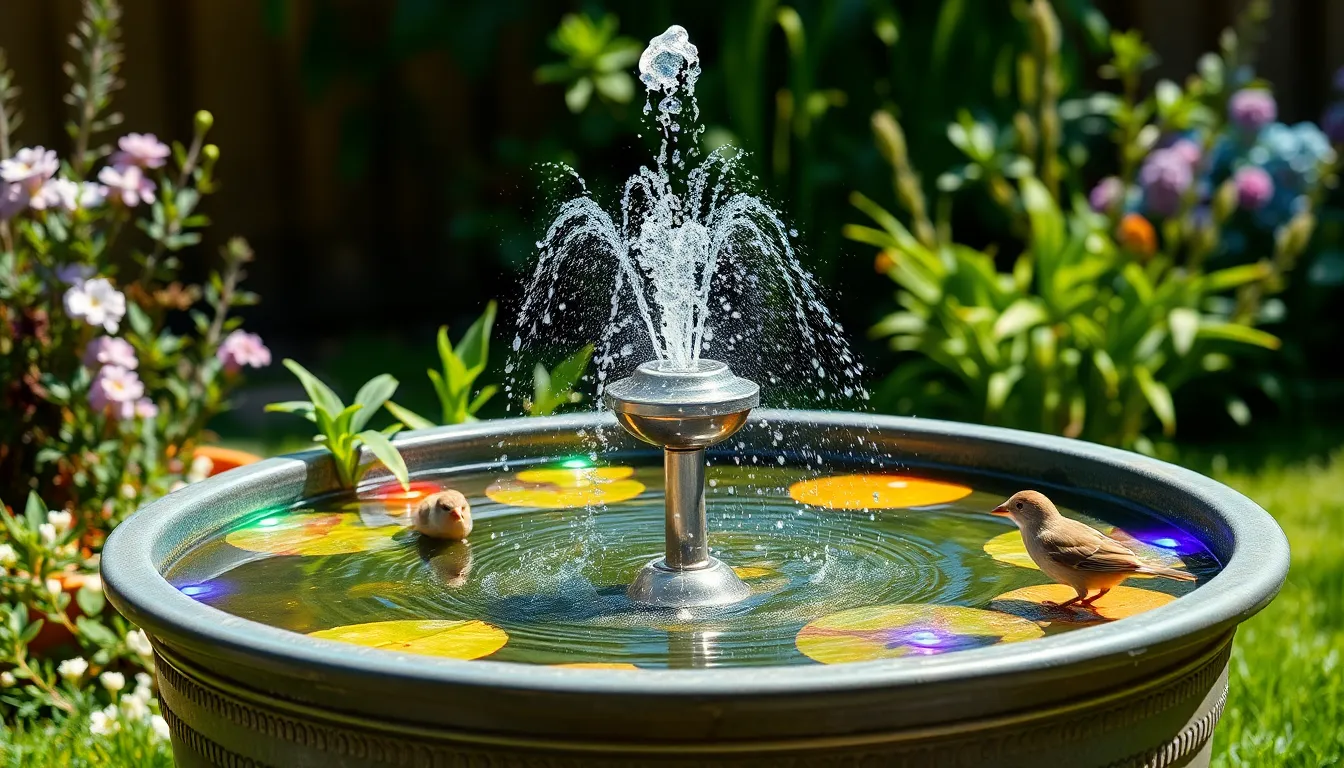
Equipping your container pond with the right components transforms a simple water feature into a thriving aquatic network. We’ll guide you through the essential equipment that ensures your container pond operates efficiently and remains visually stunning year-round.
Select Appropriate Water Pumps and Filters
Water pumps maintain proper circulation while preventing stagnation in your container pond. We recommend choosing pumps that match your container’s water volume, typically requiring 50-100 gallons per hour circulation rate for small ponds. Small submersible pumps work exceptionally well for containers holding 20-50 gallons of water.
Filtration systems keep water clarity optimal and support healthy aquatic life. We suggest installing compact biological filters that combine mechanical and biological filtration processes. Sponge filters provide excellent biological filtration for container ponds, while canister filters offer superior mechanical cleaning capabilities.
Pump placement affects overall water movement and oxygenation throughout your container. We position pumps at the deepest point to ensure complete water circulation and prevent dead zones where debris accumulates.
Add Solar-Powered Fountain Features
Solar fountain pumps create beautiful water movement while operating completely off-grid. We find that solar-powered fountains with battery backup systems provide consistent operation during cloudy conditions and evening hours. These units typically generate 40-80 gallons per hour flow rates, perfect for container pond applications.
Fountain heads determine water display patterns and sound levels in your outdoor space. We install adjustable spray heads that allow customization of water height and spread patterns. Bell fountains create gentle bubbling sounds, while tiered fountains produce more dramatic water displays.
Wildlife attraction increases significantly when fountains provide fresh water movement and accessibility. We’ve observed that gentle fountain flow rates attract birds, butterflies, and beneficial insects more effectively than high-pressure displays.
Incorporate LED Lighting for Nighttime Appeal
LED pond lights extend viewing pleasure into evening hours while consuming minimal electricity. We install submersible LED fixtures rated for continuous underwater operation, typically requiring 3-12 watts per light depending on container size. Color-changing LED systems offer versatility for seasonal displays and special occasions.
Lighting placement strategies maximize visual impact while ensuring safety around water features. We position lights to illuminate both water surface and surrounding industry elements. Uplighting from pond bottom creates stunning water column effects, while perimeter lighting defines pond edges for nighttime navigation.
Nocturnal wildlife benefits from strategically placed lighting that doesn’t disturb natural behaviors. We use warm white LEDs with dimming capabilities to attract beneficial insects while avoiding harsh glare that disrupts wildlife patterns. Timer controls automate lighting schedules, reducing energy consumption while maintaining consistent nighttime ambiance.
Stock Your Container Pond with Aquatic Life
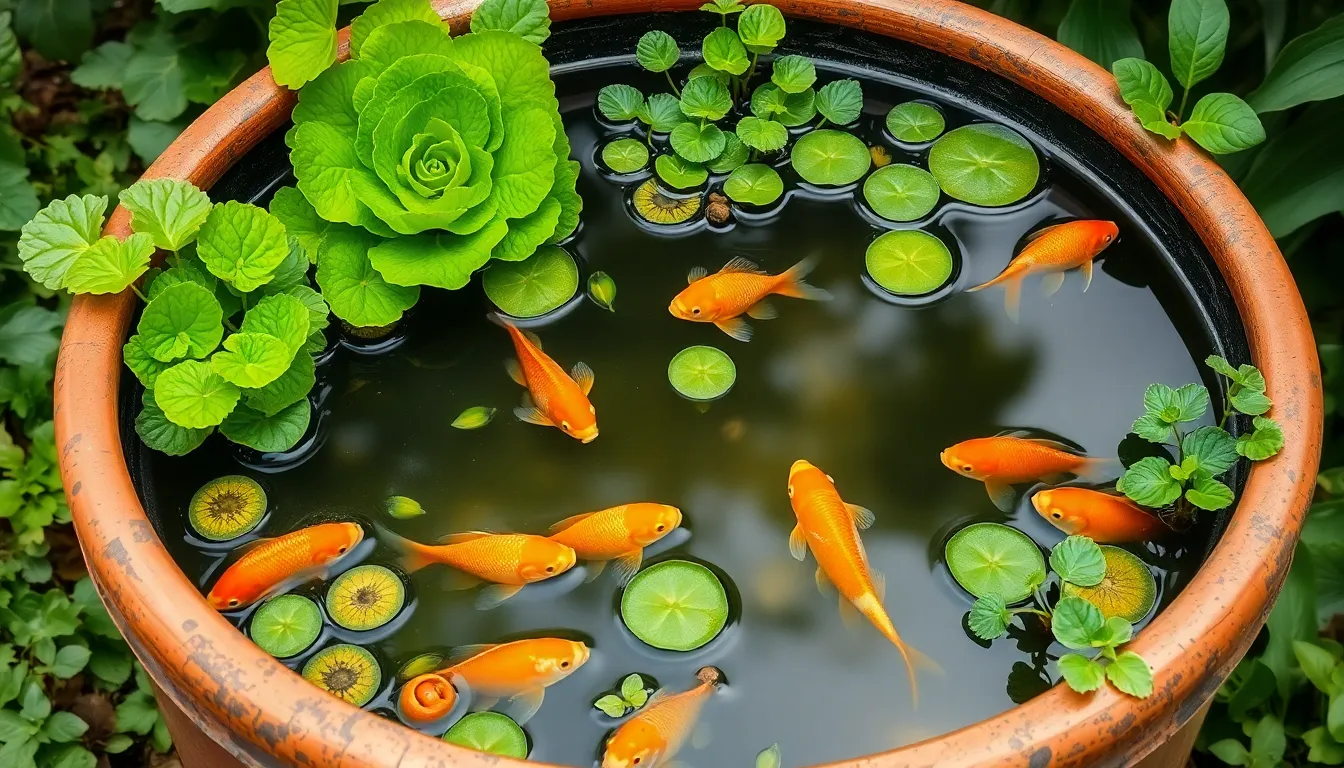
Adding the right aquatic life transforms your container pond from a simple water feature into a thriving network. We’ll explore the best fish, beneficial creatures, and plants that work together to create balance and beauty in your miniature aquatic industry.
Introduce Hardy Goldfish and Koi Varieties
Hardy goldfish varieties like fantail and comet goldfish thrive in container pond environments and provide excellent mosquito control. These adaptable fish handle temperature fluctuations better than tropical species, making them perfect for outdoor container ponds. We recommend starting with 2-3 small goldfish in containers that hold at least 40 gallons of water to prevent overcrowding.
Small koi varieties can work in larger container ponds, but they require more space and deeper water than goldfish. Choose juvenile koi that won’t outgrow your container, keeping in mind that these fish can live for decades and grow considerably. Container size becomes critical here – we suggest reserving koi for containers holding 100+ gallons to ensure proper growth and health.
Proper fish density prevents water quality issues and stress among your aquatic pets. Calculate approximately 20 gallons of water per inch of fish length to maintain healthy conditions. Monitor your fish regularly for signs of overcrowding like gasping at the surface or aggressive behavior, which indicates you need to reduce numbers or upgrade to a larger container.
Add Beneficial Snails and Aquatic Insects
Ramshorn snails serve as natural algae cleaners and help process decaying plant matter in your container pond. These hardy snails reproduce readily, so start with just 2-3 individuals to establish a population. We find they’re particularly effective at cleaning glass surfaces and keeping water clear without requiring any special care.
Trapdoor snails offer similar cleaning benefits but reproduce more slowly than ramshorn varieties. These larger snails excel at consuming dead plant material and leftover fish food that could otherwise pollute your water. Add 1-2 trapdoor snails per 20 gallons of water for optimal cleaning power.
Water beetles and dragonfly nymphs contribute to ecological balance by controlling mosquito populations and other pest insects. These beneficial predators occur naturally in many outdoor water features, but you can introduce them by adding pond water from established natural sources. We suggest allowing these insects to colonize naturally rather than purchasing them, as they’ll arrive when conditions are right.
Balance Network with Floating Plants
Water lettuce (Pistia stratiotes) provides excellent surface coverage and rapid nutrient absorption to prevent algae blooms. These floating plants spread quickly, so we recommend starting with 2-3 plants and removing excess growth monthly. Their roots create spawning areas for fish while their leaves offer shade and protection from predators.
Water hyacinth (Eichhornia crassipes) adds stunning purple blooms and exceptional water filtering capabilities to container ponds. Each plant can absorb important amounts of nutrients that would otherwise feed unwanted algae. We suggest checking local regulations before introducing water hyacinth, as it’s restricted in some areas due to its aggressive growth.
Water mint (Mentha aquatica) combines aromatic benefits with practical water management in container pond systems. This floating herb releases pleasant scents when brushed against and helps maintain water quality through natural filtration. Plant water mint in small containers within your pond to control its spread while enjoying its dual benefits as both aquatic plant and culinary herb.
Position Your Container Pond for Maximum Impact
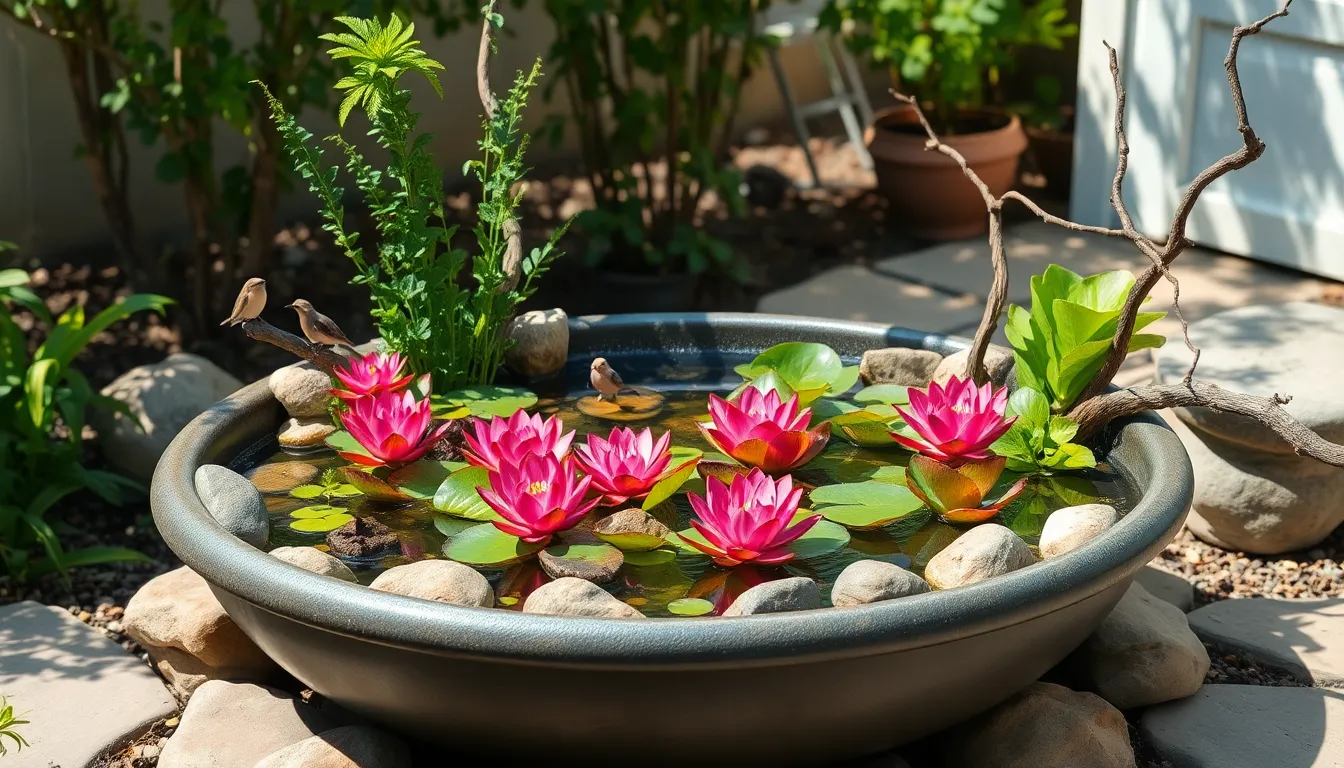
Strategic placement transforms your container pond from a simple water feature into a captivating outdoor centerpiece. We’ll explore how optimal positioning maximizes both visual appeal and practical functionality.
Find the Ideal Location for Sun and Shade Balance
Sunlight requirements form the foundation of successful container pond placement. We recommend positioning your water feature to receive at least six hours of direct sunlight daily for optimal plant growth and water quality. Most aquatic plants thrive in full sun conditions, developing vibrant blooms and robust foliage that enhance your pond’s visual impact.
Shade considerations prevent overheating and excessive algae growth during peak summer months. We suggest selecting locations that offer some natural shade during the hottest part of the day, typically between 12 PM and 3 PM. Trees, pergolas, or strategically placed umbrellas provide excellent shade sources without blocking essential morning and evening light.
Accessibility factors ensure your container pond remains enjoyable and maintainable throughout the seasons. We position our ponds within easy reach of water sources and electrical outlets for pumps and lighting systems. Choosing locations near patios, decks, or frequently used garden paths allows for effortless daily observation and routine maintenance tasks.
Create Stunning Focal Points in Small Spaces
Wildlife integration transforms container ponds into active ecosystems that attract beneficial creatures. We install underwater ramps and shelves using flat stones or bricks to create easy access points for birds, frogs, and beneficial insects. These features double as perching spots and escape routes, making your pond both functional and wildlife friendly.
Plant selection strategy maximizes visual impact within limited container space. We choose compact aquatic varieties like dwarf water lilies, water lettuce, and miniature cattails that provide maximum beauty without overwhelming smaller containers. These low maintenance plants create lush displays while maintaining proper water balance and oxygenation.
Decorative elements add vertical interest and natural charm to container pond installations. We incorporate large stones, weathered branches, and sculptural pieces that complement the surrounding industry design. These additions create multiple viewing angles and provide resting spots for visiting wildlife while improving the overall aesthetic appeal.
Integrate Multiple Containers for Layered Effects
Layered arrangements create sophisticated water features using containers of varying sizes and heights. We position larger containers as anchor points, then surround them with medium and small vessels to establish visual flow and depth. This tiered approach maximizes water surface area while creating interesting sight lines from multiple viewing angles.
Plant diversity strategies enhance the ecological balance and visual appeal of multi container installations. We assign different plant types to each vessel, combining floating species in larger containers with marginal plants in smaller ones. This approach promotes biodiversity while creating varied textures, colors, and seasonal interest throughout your water garden display.
Repurposed material opportunities add unique character and sustainability to layered container pond designs. We transform old sinks, bathtubs, and ceramic vessels into distinctive water features that tell stories while providing functional growing spaces. These unexpected elements create conversation pieces while demonstrating creative resourcefulness in garden design.
Maintain Your Container Water Garden Year-Round
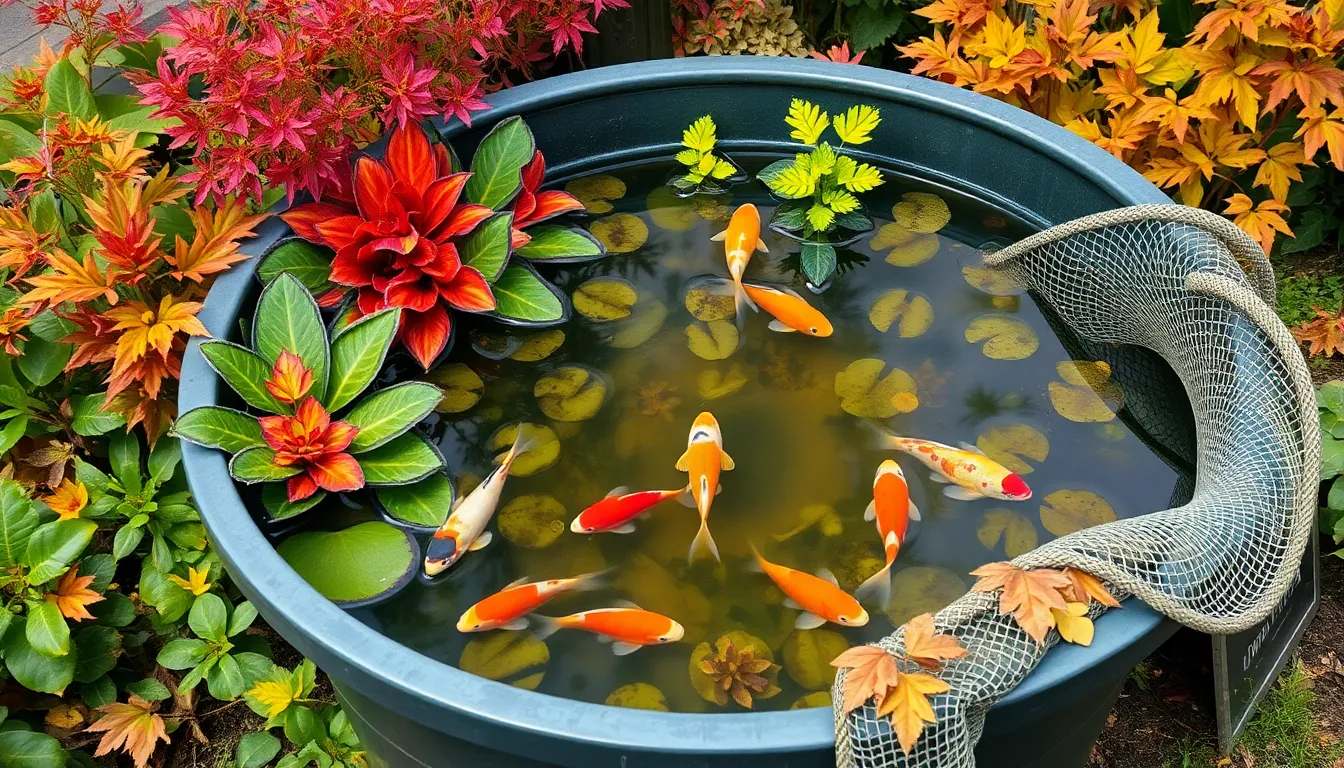
Container pond maintenance requires consistent attention throughout all seasons to ensure your aquatic paradise thrives. We’ll guide you through essential practices that protect your investment and keep your water garden beautiful year-round.
Perform Regular Water Testing and Cleaning
Water quality testing forms the foundation of successful container pond maintenance. We recommend checking pH levels, ammonia, and nitrate concentrations weekly during active growing seasons using simple test strips or digital meters.
Surface debris removal should happen daily using a fine mesh net to collect fallen leaves, dead insects, and plant matter before they decompose and affect water chemistry. Bottom cleaning requires more thorough attention, as sediment buildup can harbor harmful bacteria and reduce oxygen levels for fish and plants.
Filter maintenance keeps your pond pump operating efficiently and prevents costly equipment failures. We suggest cleaning your filter system every two weeks during summer months, rinsing filter media in pond water rather than tap water to preserve beneficial bacteria colonies.
Algae control becomes manageable through regular maintenance rather than reactive treatments. Removing string algae by hand when it first appears prevents massive blooms that can overwhelm your container’s network.
Prepare for Winter Weather and Freezing Temperatures
Winter preparation protects your container from weather damage and ensures aquatic life survival during harsh conditions. Excess water removal after heavy rainfall prevents overflow that can damage your container’s finish and surrounding landscaping.
Ice expansion planning requires leaving adequate space at the water’s surface, typically 2-3 inches below the rim, allowing frozen water to expand without cracking your container. Ceramic and concrete containers need special attention since they’re more susceptible to freeze damage than plastic or fiberglass options.
Equipment winterization involves removing and storing pumps, filters, and fountains in temperatures below freezing. We recommend cleaning all equipment thoroughly before storage to prevent mineral buildup and bacterial growth during dormant months.
Plant protection varies by hardiness zones, with tender aquatic plants requiring indoor storage while hardy varieties can remain outdoors with proper insulation around the container base.
Schedule Seasonal Plant Care and Fish Feeding
Spring awakening begins with adding fresh oxygenating plants like anacharis to control algae growth as water temperatures rise above 50°F. Plant trimming removes winter damaged foliage and prevents decomposing leaves from affecting water quality during the active growing season.
Summer maintenance focuses on balanced network management through regular plant pruning and ensuring adequate water circulation during peak temperatures. Fish feeding increases to daily portions as their metabolism accelerates, while plant fertilization supports vigorous growth without overwhelming the system.
Autumn preparation involves removing yellowing leaves and trimming plant foliage before frost arrives. We reduce algae control measures as cooler temperatures naturally slow algae reproduction, allowing beneficial bacteria to establish winter balance.
Winter care minimizes plant growth through reduced fertilization and protects the pond from complete freezing using floating de-icers in areas with harsh winters. Fish feeding stops entirely when water temperatures drop below 50°F, as their digestive systems cannot process food efficiently in cold conditions.
Troubleshoot Common Container Pond Problems
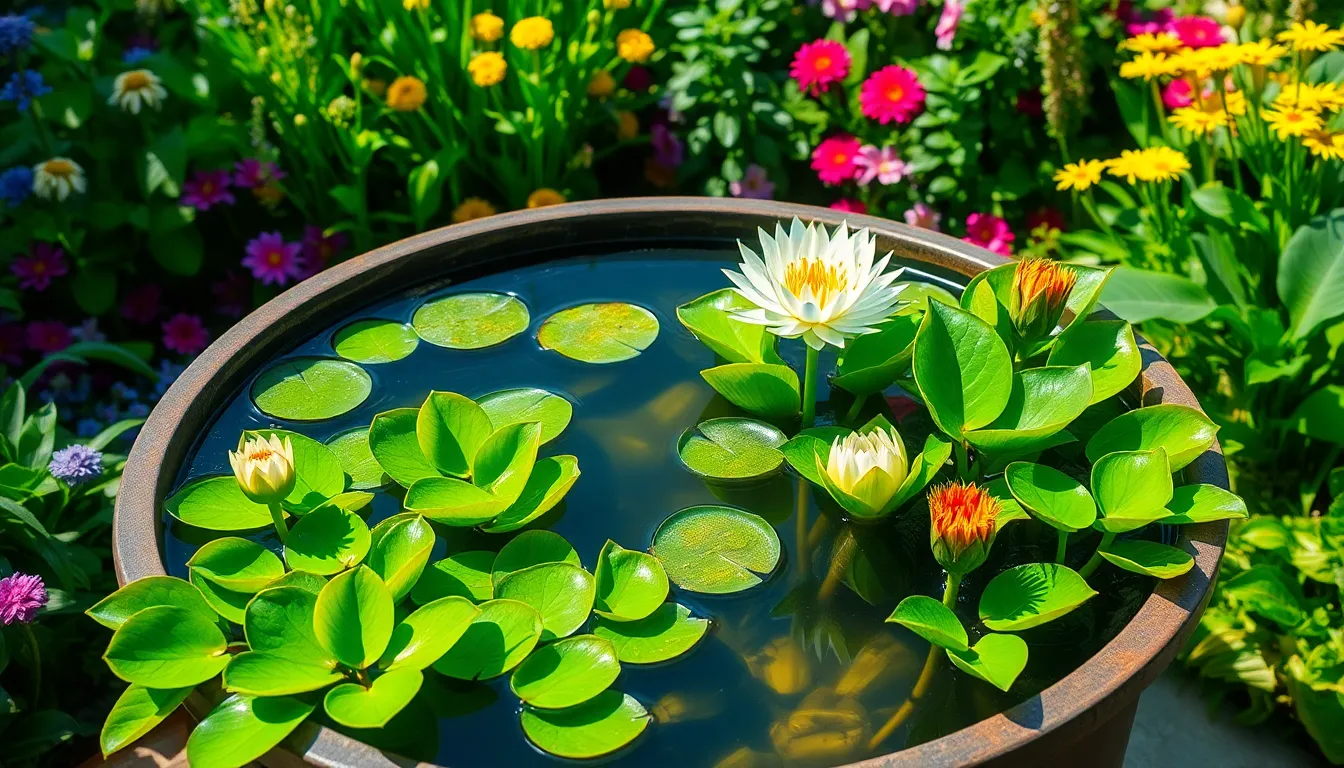
Even well-maintained container ponds can develop issues that require prompt attention. We’ll guide you through answers for the most common problems that affect water quality and plant health.
Prevent Algae Overgrowth and Green Water Issues
Balance your plant selection to create natural competition for nutrients that algae need to thrive. Underwater oxygenating plants like anacharis work as living filters by absorbing excess nutrients while releasing oxygen into the water. We recommend filling about one-third of your pond volume with these beneficial plants to maintain clear water conditions.
Provide adequate shade using floating plants such as water lilies or duckweed to reduce direct sunlight penetration. These natural umbrellas prevent excessive algae growth by blocking the light energy that fuels photosynthesis. Floating plants should cover approximately 50-70% of your water surface for optimal algae control.
Apply natural algae inhibitors like barley extract or barley straw products to suppress algae growth without harming fish or beneficial bacteria. We suggest using these treatments seasonally, adjusting frequency based on your pond’s exact algae patterns and environmental conditions.
Address Water Level Fluctuations and Evaporation
Monitor water levels regularly and add fresh water to compensate for natural evaporation, especially during summer months or windy conditions. Container ponds lose water faster than larger installations due to their smaller volume and greater surface area exposure.
Remove excess rainwater promptly after heavy storms to prevent overflow that can damage your container’s finish or surrounding landscaping. We recommend checking water levels within 24 hours of important rainfall events.
Use dechlorinated or aged water when topping off your pond to avoid introducing harmful chemicals that can stress fish and disrupt beneficial bacteria colonies. Let tap water sit for 24-48 hours before adding it to your container pond, or use water conditioner products for immediate treatment.
Manage Plant Overcrowding and Root Bound Conditions
Trim overgrown foliage periodically to prevent excessive leaf drop that creates organic debris in your pond water. Dead or dying plant material decomposes and reduces water quality while providing nutrients for unwanted algae growth.
Thin out floating and submerged plants when they cover more than one-third of your water surface or pond volume. Overcrowded plants block essential light and oxygen from reaching deeper water levels, creating stagnant conditions that harm fish and beneficial bacteria.
Divide and repot root bound plants by gently removing them from containers and separating overgrown root systems into smaller sections. Replant these divisions in fresh aquatic soil or clean gravel to encourage healthy new growth and prevent nutrient depletion in your pond network.
Conclusion
We’ve shown you that creating stunning container ponds doesn’t require extensive landscaping experience or a massive budget. These versatile water features can transform any outdoor space into a peaceful retreat while providing endless opportunities for creativity and customization.
Whether you choose a rustic whiskey barrel or a sleek modern planter your container pond will become a captivating focal point that attracts wildlife and enhances your garden’s natural beauty. With proper planning equipment selection and maintenance techniques you’ll enjoy years of tranquil water gardening success.
The beauty of container ponds lies in their adaptability – you can start small and expand your collection or relocate them as your needs change. We’re confident that these ideas will inspire you to create your own aquatic oasis that brings joy and serenity to your outdoor living space.
Frequently Asked Questions
What is a container pond?
A container pond is a small water feature created using various containers like ceramic pots, wooden barrels, or plastic storage containers. It’s an accessible alternative to traditional in-ground ponds that doesn’t require excavation or large budgets. Container ponds can house aquatic plants, fish, and create tranquil water features in any outdoor space.
What size container do I need for a pond?
Your container should be at least 18 inches wide and 12 inches deep to support aquatic plants and create a stable ecosystem. For water gardens with lotus or water lilies, choose containers that are 5-8 inches deep minimum. Larger containers provide better water stability and more space for plants to thrive.
Can I keep fish in a container pond?
Yes, you can keep hardy goldfish and small koi varieties in container ponds. Maintain proper fish density to ensure good water quality – avoid overcrowding. The fish help control pests like mosquitoes while adding visual appeal. Ensure your container is large enough and has proper filtration for fish health.
What equipment do I need for a container pond?
Essential equipment includes water pumps for circulation, filtration systems for water clarity, and optionally solar-powered fountains for movement. LED lighting can extend evening enjoyment, while proper filtration prevents algae growth. Choose equipment sized appropriately for your container’s volume to ensure optimal performance.
Where should I place my container pond?
Position your container pond to receive at least 6 hours of direct sunlight daily, but also consider partial shade to prevent overheating and algae growth. Place it near water sources for easy maintenance and along frequently used garden paths for accessibility and visual impact.
How do I maintain my container pond year-round?
Regular maintenance includes water testing, cleaning, and filter maintenance to prevent algae growth. Prepare for winter by winterizing equipment and protecting plants based on your hardiness zone. Adjust plant management and fish feeding seasonally, and monitor water levels regularly to maintain ecosystem balance.
What plants work best in container ponds?
Choose compact aquatic plants like water lettuce, water hyacinth, and water mint for smaller containers. Lotus and water lilies need larger containers with proper spacing. Native plants and floating varieties help maintain balanced water conditions while providing habitat for beneficial insects and wildlife.
How do I prevent algae in my container pond?
Prevent algae by balancing plant selection to create nutrient competition, using floating plants for shade, and maintaining proper filtration. Avoid overfeeding fish, ensure adequate water circulation, and consider natural algae inhibitors. Regular cleaning and monitoring water quality are essential for algae prevention.

